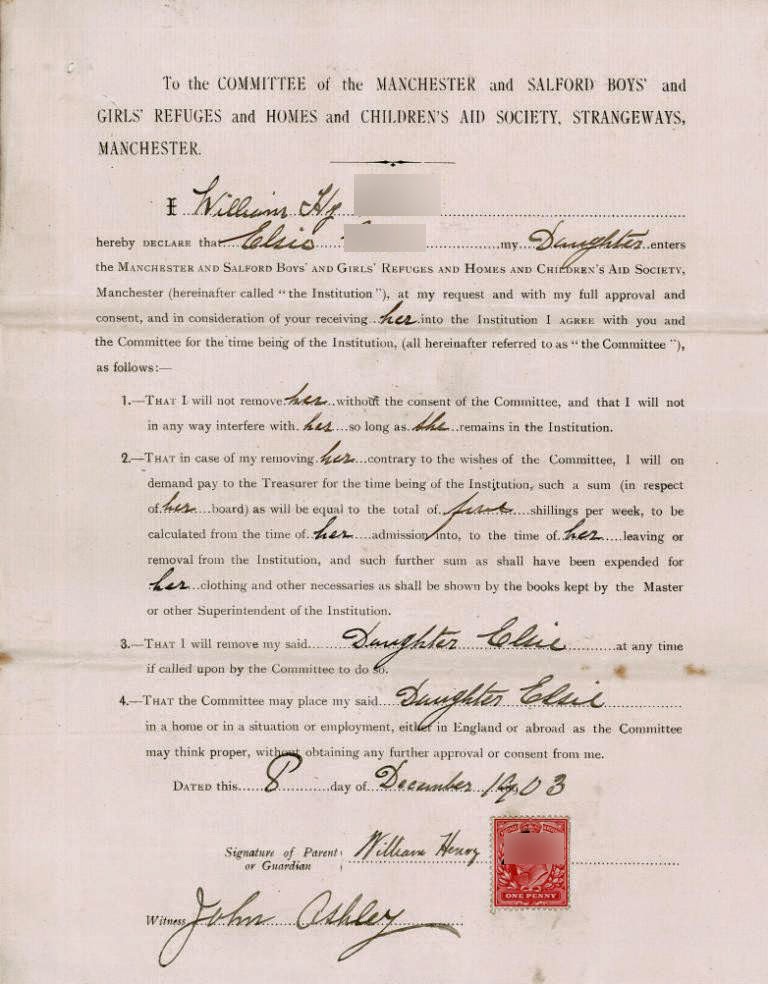Youth Indentures
On a journey to the archives this week, one case file turned up a new document. Most of these case files are fairly similar in content. All contain the now familiar admission form detailing child’s circumstances, parent’s names, previous addresses etc. Other common documents include visitor’s reports, letters from concerned individuals and indentures that are signed by a parent or guardian of the child.
The indenture represents certain conditions that were expected to be adhered to by the guardian on placing the child within one of the charity homes. These included: not removing the child without the committee’s permission and if done so to pay a monetary penalty; to remove the child if requested to do so; and agreeing for the child to be placed in a situation or employment both home or abroad. These were quite common records found within the case file. What has not been seen before however, were youth indentures that were signed by the child on admission.
The above example, signed in 1891, also required certain stipulations to be adhered to. “I Josiah, having no home or fixed residence, and being in a destitute condition, humbly beg to be admitted into ‘THE BOYS’ REFUGE, STRANGEWAYS’”. The indenture goes on to confirm that once admitted, Josiah would promise to obey all rules and regulations of the house, not to leave without permission and to return any items lent to him on discharge. It appears that the 12 year old Josiah signed this document himself.
It is worth considering why there are so few of these documents in the archive. Josiah’s case is similar to many others; he was admitted from the workhouse after the death of his mother and desertion of his father. It is possible he had no close relatives to sign an adult indenture for him so he signed his own agreement. It is also possible that many of these were delivered verbally as it is likely many of the children would not be able to write their own name or possibly that this document was withdrawn soon after being produced.
Despite their rarity it is an interesting document to come across, to show what was expected of the children on admittance. It represents another insight into their world.
 |
|
Parent
Indenture, 1903
|
The indenture represents certain conditions that were expected to be adhered to by the guardian on placing the child within one of the charity homes. These included: not removing the child without the committee’s permission and if done so to pay a monetary penalty; to remove the child if requested to do so; and agreeing for the child to be placed in a situation or employment both home or abroad. These were quite common records found within the case file. What has not been seen before however, were youth indentures that were signed by the child on admission.
Youth Indenture, 1891
The above example, signed in 1891, also required certain stipulations to be adhered to. “I Josiah, having no home or fixed residence, and being in a destitute condition, humbly beg to be admitted into ‘THE BOYS’ REFUGE, STRANGEWAYS’”. The indenture goes on to confirm that once admitted, Josiah would promise to obey all rules and regulations of the house, not to leave without permission and to return any items lent to him on discharge. It appears that the 12 year old Josiah signed this document himself.
It is worth considering why there are so few of these documents in the archive. Josiah’s case is similar to many others; he was admitted from the workhouse after the death of his mother and desertion of his father. It is possible he had no close relatives to sign an adult indenture for him so he signed his own agreement. It is also possible that many of these were delivered verbally as it is likely many of the children would not be able to write their own name or possibly that this document was withdrawn soon after being produced.
Despite their rarity it is an interesting document to come across, to show what was expected of the children on admittance. It represents another insight into their world.


Comments
Post a Comment
Like to know more about a certain home or period in the Together Trust's history? Why not comment and let us know.
If you have a personal or more specific enquiry please see our 'Contact Us' section at the top of this page to get in touch via email.